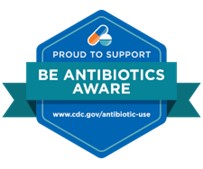Antimicrobial Stewardship
 Antimicrobial stewardship (AS) is a coordinated program that promotes the appropriate use of antimicrobials (including antibiotics), improves patient outcomes, reduces microbial resistance, and decreases the spread of infections caused by multidrug-resistant organisms. Antimicrobials are a form of medicine designed to kill or stop the growth of microorganisms, such as fungus or viruses. An antibiotic is a type of antimicrobial designed to kill bacteria.
Antimicrobial stewardship (AS) is a coordinated program that promotes the appropriate use of antimicrobials (including antibiotics), improves patient outcomes, reduces microbial resistance, and decreases the spread of infections caused by multidrug-resistant organisms. Antimicrobials are a form of medicine designed to kill or stop the growth of microorganisms, such as fungus or viruses. An antibiotic is a type of antimicrobial designed to kill bacteria.
Overview
The use of antimicrobials is the single most important factor leading to antimicrobial resistance (AR) around the world. In 2019, the Centers for Disease Control and Prevention’s (CDC) Antibiotic Resistance Threat Report estimated more than 2.8 million people are infected with AR organisms, and approximately 35,000 of these infections result in death in the United States annually.
In United States acute care hospitals, the CDC estimates that 20-50% of all antibiotics prescribed are either unnecessary or inappropriate. Through the promotion of evidence based AS programs, we can improve individual patient outcomes, reduce overall burden of AR, and decrease healthcare costs.
The Antimicrobial Stewardship Team
The AS Team at Texas Department of State Health Services (DSHS) promotes interventions to measure and improve antimicrobial use through the CDC’s “5 D's” and Core Elements of AS.
5 D's of Antimicrobial Stewardship:
- Diagnosis: the patient’s diagnosis requires antimicrobial use
- Drug choice: the drug treats the organism that is present
- Dose: the recommended dose is within the correct range
- Duration of therapy: appropriate medication period
- De-escalation: the organism is no longer present and drug therapy can be reduced or stopped, preventing excess antimicrobial use.
Website: NIH Antimicrobial Stewardship.
CDC’s Core Elements of Antimicrobial Stewardship:

- Leadership commitment: Dedicating resources
- Accountability: Single leader
- Drug expertise: Single pharmacist leader
- Action: Implementing at least one recommended action
- Tracking: Monitoring antimicrobial prescribing and resistance patterns
- Reporting: Regular AR and antimicrobial use reporting
- Education: Informing clinicians about resistance, optimal prescribing
Antimicrobial Stewardship Projects:
Contact Us At:
Email: AntibioticStewardship@dshs.texas.gov
Join our mailing list to learn about trainings, webinars, and other AS initiatives from the HSU.

